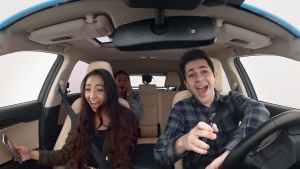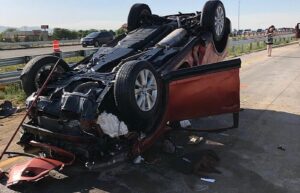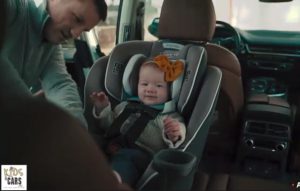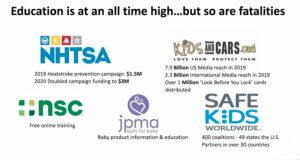If you’re one of the millions of Americans who have been working from home and spending hours a day in video meetings you might notice it can become difficult pulling your thoughts back together at the end of the day. And if you then have to climb behind the wheel that could prove deadly.
A new study raises concerns about “Zoom Zombies,” motorists who can’t fully focus on the road ahead after a day of videoconferencing. This may be one of the reasons why in 2020 U.S. highway deaths posted their biggest year-over-year increase in nearly a century.
“COVID-19 fundamentally changed the way we interact with our vehicles,” said David Timm, founder and CEO of Root Insurance, which raised concerns about Zoom Zombies in its annual Distracted Driving Awareness Survey. “As many abruptly shifted to a virtual environment, Americans’ reliance on technology dramatically increased along with their screen time, causing a majority of drivers to carry this distracted behavior into their vehicles.”
Covid-19 and the distracted driving pandemic
Distracted driving has become an increasingly serious problem as more and more motorists interact with smartphones and other technology while behind the wheel. Even before the COVID pandemic, the National Highway Traffic Safety Administration estimated that more than 10% of highway fatalities involved distracted driving. Preliminary analysis suggests that has gone up since last year’s lockdowns began.
The Roots study found 64% of the U.S. motorists it surveyed acknowledging they check their phones while driving. That’s up 2% from last year, and 6% from the 2019 Distracted Driving Awareness Survey. Meanwhile, 53% of the respondents said they check their phones within the first 15 minutes behind the wheel — a 9% jump from 2019 — when they should be trying to shift focus to driving.
Add the fact that drivers are downplaying the risks. The study found three in 10 drivers don’t see the risk of driving while using a mobile phone. That’s up from 24% just a year ago.
But the study raised another concern: even when motorists aren’t texting or chatting on their phones, they still might not be paying full attention to the job of driving.

Younger drivers are more likely to have trouble concentrating on the road after engaging in some sort of video conference call.
The younger the driver, the worse the problem
Root reports that 54% of the 1,819 adult motorists it surveyed have had trouble concentrating on the road after making videoconference calls with Zoom, Microsoft Meet or some other software platform. The younger the driver, the worse the problem. For Gen Z motorists, 65% reported losing focus while driving, while it was 61% for millennials and 48% for Gen-Xers.
“The problem with distraction is huge and it’s not just checking e-mail or texting,” said Russ Rader, an executive with the Insurance Institute for Highway Safety. “There’s the risk of cognitive distraction, looking at the road while your thoughts are elsewhere. That zoning out may mean you don’t notice a dangerous situation soon enough to react.”
Whether you call them “Zoom Zombies” or “Zoombies,” the problem has gained widespread attention, and concern — especially when it comes to driving.

If it appears drivers has seemingly forgotten how to drive as pandemic-related restrictions eased, it’s because, well, they have.
“I think computer use, in general, can overload you,” especially after a series of videoconference meetings, said Joan Claybrook, a former NHTSA administrator and longtime auto safety advocate. “After you get into your car you may be operating on auto pilot.”
Driving skills have atrophied
That’s all the worse as we emerge from the pandemic, experts told TheDetroitBureau.com. During the last 12 months, most Americans have been driving less and even as roadways begin to look more crowded, “driving skills have atrophied for many people,” warns Sam Abuelsamid, principal auto analyst with Guidehouse Insights.
“It’s become harder to drive safely because you’re going to forget some of the skills you learned over time,” added Abuelsamid. “It’s not as easy as just jumping back on a bike.”
While he believes Zoom fatigue is “likely a contributor to the increase in highway fatalities,” how much it contributes is uncertain. What’s clear is that highway fatalities soared in 2020, even as motorists slashed the number of miles they drove.
Record surge in fatalities
Preliminary data indicated as many as 42,060 Americans were killed in motor vehicle crashes last year, the National Safety Council reported last month. That was an 8% increase from 2019. That surge occurred even though Americans drove a total of 2.83 trillion miles in 2020. That was a 13.2% decrease from the year before, marking the lowest level of driving by American motorists in two decades, reported the U.S. Federal Highway Authority.

Traffic fatalities rose in 2020, rising 8%, but the death rate, the number of deaths per miles driven, jumped 24% compared with 2019.
So, on a per mile basis, the death rate surged by 24% in 2020, the biggest year-over-year increase since 1924.
Why does “Zooming” take so much out of people? It’s not like sitting around a table for an in-person meeting. Key visual cues are absent, such as body language, while others can overwhelm, according to psychologist Sharon Parker, director of the Centre for Transformative Work Design.
They tend to be sharply focused, without the normal chit-chat and other interactions that come before — sometimes during — and after in-person meetings, Parker wrote. One result: participants come away struggling to interpret what actually happened rather than transferring attention to what comes next.
And that may extend beyond the work day to when you’re behind the wheel and should be focusing on the road ahead.
/**/





